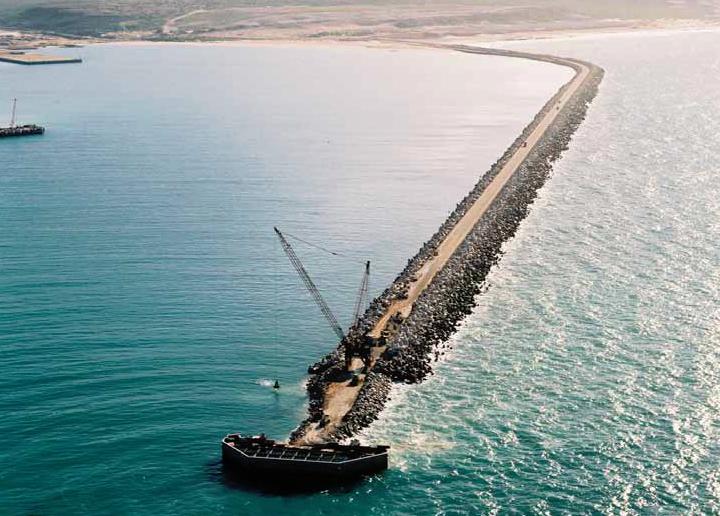
South Africa-based consulting port and coastal engineers Prestedge Retief Dresner Wijnberg is finding success all over the world, with its projects designed and built to withstand the toughest challenges that nature can throw at them, as Julia Smith discovers.
Since its formation in 1992, Prestedge Retief Dresner Wijnberg (PRDW) has assembled a formidable team of engineering talent. CEO Gordon Prestedge now heads an international consulting and engineering team which can point to a growing portfolio of flagship projects encompassing ports and harbour installations, marine structures for power stations and petrochemical plants, water and waste facilities and coastal developments. “We are at the forefront of planning and designing key technical aspects of major projects in several parts of the world,” says Prestedge.
The company is partly owned by Illiso Consulting, one of the largest black owned and managed consulting engineering firms in South Africa, which acquired a 25 per cent stake five years ago.Since the acquisition, PRDW has steadily expanded the scope and breadth of its projects, as well as its geographical reach, and now has offices in Chile and the US. “A major part of our strategy is now to diversify our client base internationally,” explains Prestedge.
The company achieved international acclaim earlier this year when Chile’s Coronel Container Port withstood the huge earthquake that wrecked many of Chile’s key freight and logistic handling facilities and severely hampered aid efforts. PRDW had been tasked with the port’s structural design and it was thus a great source of satisfaction when the port structures and container handling equipment survived the crisis without damage—a crisis which left most neighbouring facilities in ruins or out of operation for months. “We are especially proud of that achievement, given the magnitude of this major earthquake,” says Prestedge.
Closer to home, PRDW has been instrumental in the flagship project to widen and deepen the entrance to the Port of Durban. “This has been a major project for us, and it has just been completed ahead of time and within budget,” says Prestedge. The entrance has been widened from 120 metres to 220 metres and the access passage deepened from 12.8 metres to 19 metres at its deepest point. This will now allow the next generation of super large 9,000 TEU container vessels to safely navigate the harbour. These vessels are rapidly growing in importance to freight and logistics providers because of the savings that can be realised by economies of scale; however, their size and draught means that many existing container ports cannot accommodate them.
The Port of Durban is strategically sited on one of the world’s most important shipping routes and is set to play an increasingly pivotal role in the economic life of southern Africa. It is the busiest port on the entire African continent, with a throughput of over 30 million tonnes of cargo last year—this represents almost two thirds of all the containerised cargo entering South Africa.
The port is managed by the state owned logistics group Transnet, who recognised several years ago that the port’s capacity could not keep pace with the region’s economic growth. The project to widen and deepen the port has been a key feature of Transnet’s R74 billion investment programme over the last five years.
A key reason for the deepening and widening of the harbour entrance was to ensure the safety of vessels calling at the Port of Durban, as well as to enhance the port’s ability to handle larger vessels. This will result in cost savings for the port as well as having a major impact on the South African economy.
PRDW was also lead consultant for the planning and design of South Africa’s eighth deepwater harbour at Ngqura on the east coast. This became the first deepwater port in the world to receive a fixed sand bypass system using an embedded jet pump system, which replicates the natural littoral processes in order to maintain the beaches and dunefields downdrift of the man-made harbour. The system has the capacity to move up to 300,000 cubic metres of sand a year.
The demolition of the existing breakwater and buildings involved moving around 164,000 cubic metres of material, much of which was recycled into the construction of a new breakwater. The old services tunnel running underneath the entrance, as well as the existing quay and jetty structures, were demolished and replaced at a level that would not impact on any future deepening process.
Throughout the process, the colossal new structures have used 1,142 five-ton concrete blocks, 1,755 ten-ton concrete blocks, 550 dolosse and 242,000 cubic metres of rockfill on this side of the harbour.
The Durban Harbour Entrance Widening project recently won the South African Institution of Civil Engineers Durban Branch Award for Engineering Excellence.
It is envisaged that the port’s development needs will now be met for the next 60 to 100 years—during which time, no doubt, PRDW will be adding an even more impressive array of projects to its fast-expanding portfolio.www.prdw.com












